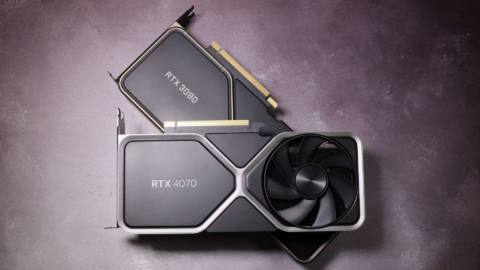We’ve suspected that Nvidia’s making an Arm processor for over a year, now, but how it will be built, what form it will take, and what market it will target are questions that have remained somewhat of a speculative mystery. Now, however, there’s possibly good news for us gamers because, rumour is, these chips will be used for relatively low-power but decently performing gaming laptops.
This rumour does come from tech YouTuber Moore’s Law is Dead (MLID), so prepare to to crank those the salt and pepper grinders. Apparently, though, a source from an Nvidia partner says the chip is “targeting up to 80 W”, and MLID quotes another unknown source as saying, “Behind the scenes, Nvidia is comparing their new APU to an RTX 4070 laptop GPU running at ~65 W in gaming performance.”
That’s not all, though, because again according to MLID, the previously quoted Nvidia partner also claims Nvidia is “at least partnering with Dell under the Alienware brand” for the new Arm-based APU. What this would mean, presumably, is a low-power but high-performing Alienware gaming laptop using an Nvidia CPU + GPU and Arm on Windows.
MLID also quotes an Nvidia source as saying “we’re trying to rush this thing out by late 2025 or 2026 at the latest”. That ties in with what we’d heard previously, that an Nvidia APU should be entering production in 2025.
The Nvidia source also reportedly says this chip’s going to be a “direct competitor to AMD’s Halo APUs” and will have a “powerful NPU”. And MLID clarifies that “they think it will be at Strix Halo performance at most, maybe a little lower”.
Regarding the NPU: Of course it’s going to have one. Because Nvidia and AI go together like Cherry and Bakewell (or Apple and Pie for the Americans in the audience). But an Nvidia APU with RTX 4070 mobile-level performance that will compete with AMD Strix Halo? That’s the real surprise, here, and it certainly tickles my fancy.
AMD’s Strix Halo chips (AKA Ryzen AI 300 Max chips) are going to be the company’s most powerful mobile chips to hit the market, featuring a healthy dolloping of RDNA 3.5 compute units. The latest leaks point towards at least three such chips, with the top-end one, the Ryzen AI Max+ 395, featuring a whopping 40 RDNA 3.5 CUs and 16 CPU cores.
For context, the Z1 Extreme APU found in handhelds such as the Asus ROG Ally X has 12 RDNA 3 CUs and 8 cores, and although it’s not an apples-to-apples comparison, the RX 7700 XT has 54 CUs.
With Strix Halo, then, we’re looking at close to high-end discrete GPU performance in a mobile chip. If this is what Nvidia’s competing against, it might make sense for them to ensure their upcoming Arm APU delivers graphics performance akin to an RTX 4070 mobile GPU as these latest rumours suggest.

Best CPU for gaming: The top chips from Intel and AMD.
Best gaming motherboard: The right boards.
Best graphics card: Your perfect pixel-pusher awaits.
Best SSD for gaming: Get into the game ahead of the rest.
Whether the chips themselves will be built by Intel or TSMC is still an open question, but with Microsoft’s Qualcomm-only Windows on Arm deal rumoured to be ending soon, we might not have to wait long to find out. If this deal is running out soon, it certainly makes sense that Nvidia’s said to be partnering with Qualcomm rival MediaTek for production of these chips.
Another potentially exciting element of this, if it’s true, is the Alienware aspect, and that’s because an all-Nvidia Alienware gaming laptop could surely only work if Windows on Arm is up to snuff.
According to MLID’s supposed Nvidia source, “there’s a HUGE effort underway to make it work”. I can kind of buy it, too, given all kinds of improvements are underway, such as an Insider build of Windows now supporting AVX and AVX2 instructions that should get more games up and running on Windows on Arm. Could Nvidia’s APU prompt a proper transition to Arm x Windows gaming? Let’s wait and see.






